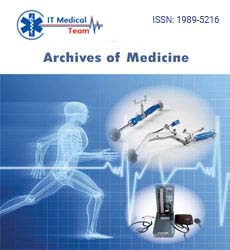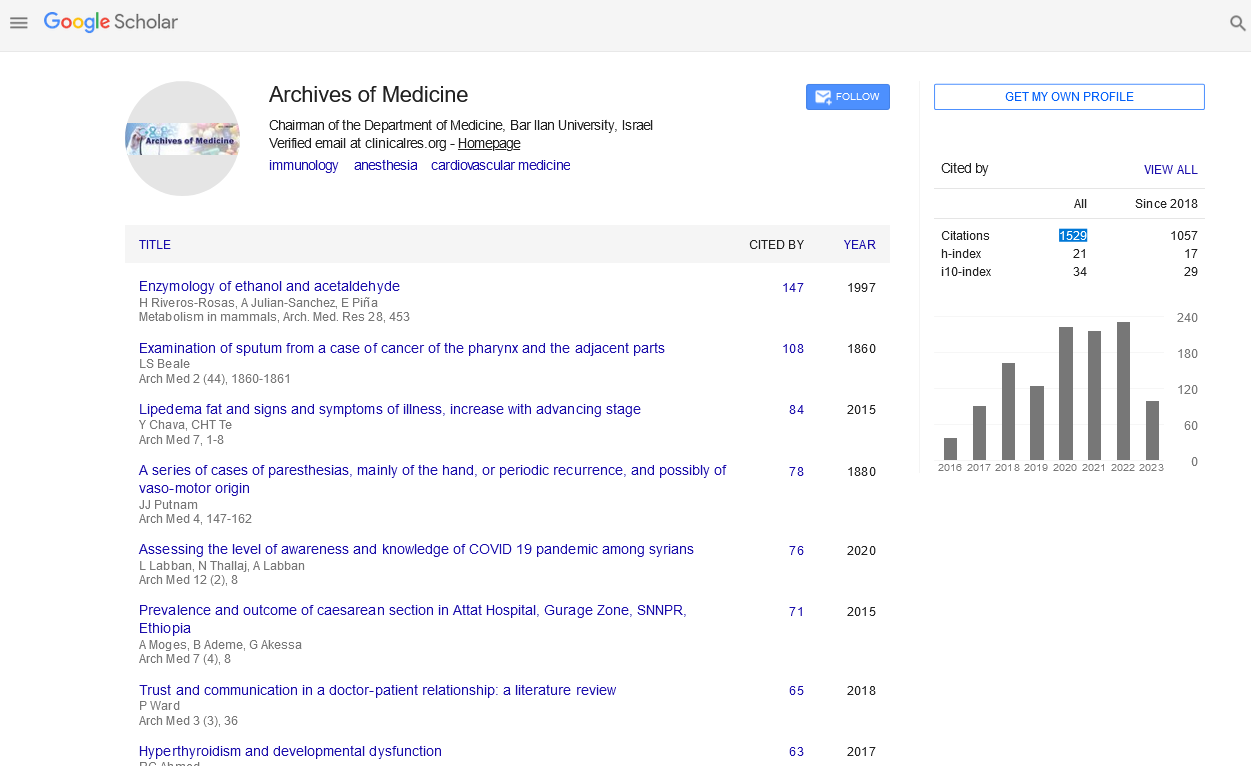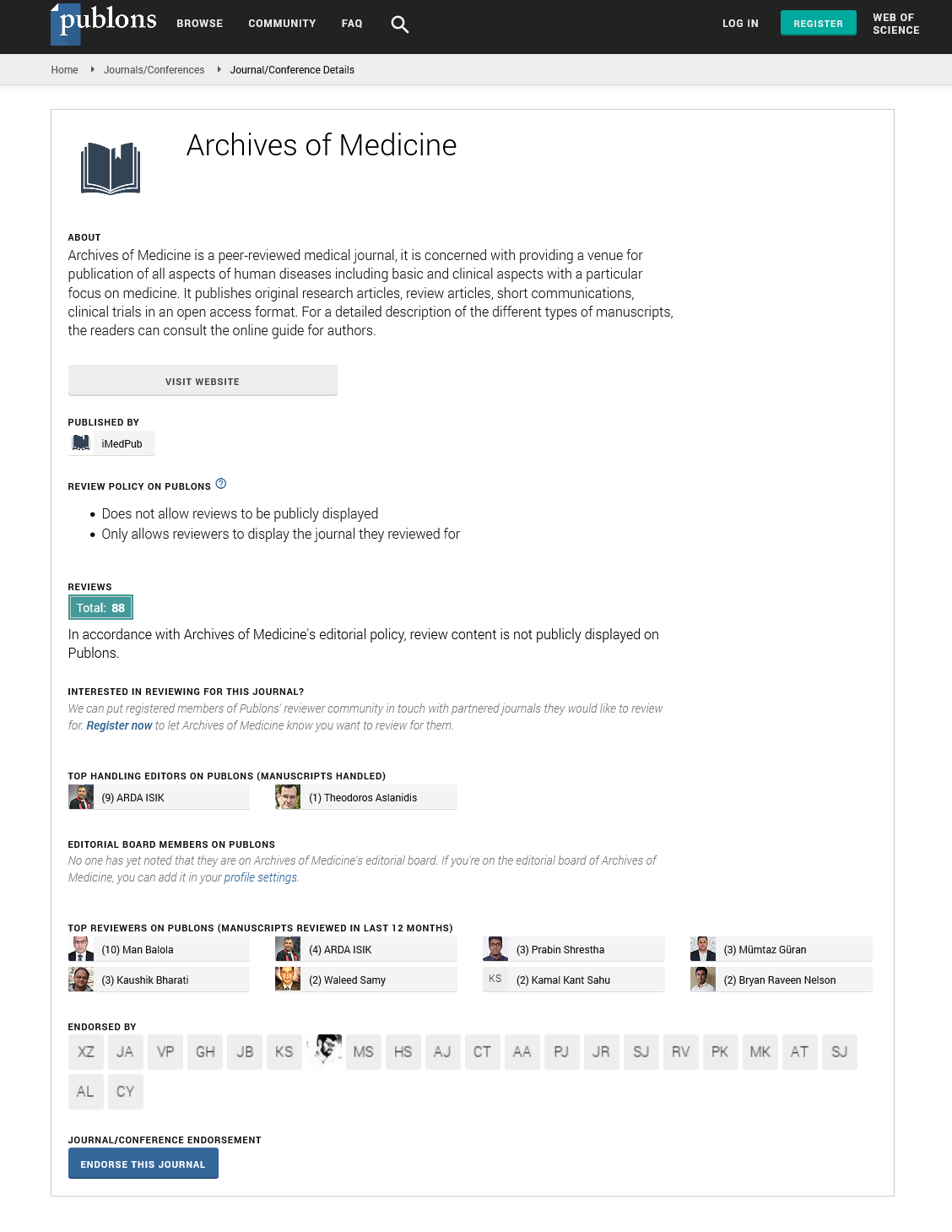Commentary - (2025) Volume 17, Issue 1
Resistant hypertension: Unveiling mechanisms and novel interventions
Amelia Hartman*
Department of Internal Medicine, University of Toronto, Toronto, ON, Canada
*Correspondence:
Amelia Hartman, Department of Internal Medicine, University of Toronto, Toronto, ON,
Canada,
Email:
Received: 03-Jan-2025, Manuscript No. ipaom-24-15472;
Editor assigned: 06-Jan-2025, Pre QC No. P-15472;
Reviewed: 17-Jan-2025, QC No. Q-15472;
Revised: 22-Jan-2025, Manuscript No. R-15472;
Published:
29-Jan-2025
INTRODUCTION
Resistant hypertension, a condition where blood pressure
remains persistently above target levels despite the concurrent
use of three or more antihypertensive agents of different
classes at optimal doses, poses a profound clinical challenge.
This complex condition affects a notable subset of individuals
diagnosed with hypertension, contributing to significantly
heightened risks of cardiovascular complications, kidney
dysfunction, and even premature mortality. The multifaceted
nature of resistant hypertension underscores the critical need
to unravel its underlying mechanisms and identify innovative
therapeutic approaches. Factors such as neurohormonal
dysregulation, lifestyle contributors, and secondary causes
often intertwine to perpetuate this condition, complicating
its management. Recent advances in medical research and
technology have illuminated potential novel interventions and
strategies, offering a beacon of hope for patients who fail to
achieve control through standard treatments. Understanding
these developments and their clinical applications is essential
for healthcare providers striving to improve outcomes in this
challenging subset of the hypertensive population [1].
DESCRIPTION
Resistant hypertension often arises from a complex
interplay of factors, including secondary causes of
hypertension, lifestyle contributors, and pharmacological
resistance. Secondary hypertension, resulting from conditions
like Obstructive Sleep Apnea (OSA), primary aldosteronism,
renal artery stenosis, or pheochromocytoma, frequently
underpins resistant cases. Identifying and addressing these
secondary causes is critical in managing the condition, as
failure to do so can lead to persistent and worsening blood
pressure levels, further complicating patient outcomes.
Advanced diagnostic tools, such as plasma renin activity and
aldosterone assays, imaging studies, and polysomnography, are
often necessary to pinpoint these underlying factors accurately.
Lifestyle factors, such as excessive sodium intake, obesity,
physical inactivity, and alcohol consumption, also play pivotal
roles in exacerbating resistant hypertension. The prevalence of
high-sodium diets, particularly in processed foods, continues
to contribute significantly to uncontrolled blood pressure
levels. Obesity not only affects the cardiovascular system
through metabolic dysregulation but also worsens sleep
apnea and insulin resistance, creating a vicious cycle that
perpetuates hypertension. Addressing these factors requires a
holistic approach that combines dietary counseling, behavioral
interventions, and, in some cases, pharmacological aids for
weight management. Additionally, poor medication adherence
due to complex regimens, side effects, or cost barriers can
further complicate treatment efforts, highlighting the need for
simplified dosing schedules and patient education [2].
Pharmacological resistance, which may occur due to genetic
factors, drug metabolism variations, or inappropriate drug combinations, contributes significantly to the persistence of high
blood pressure. For instance, polymorphisms in genes affecting
drug metabolism enzymes such as CYP3A4 and transporters
like P-glycoprotein can alter the efficacy of antihypertensive
medications. Similarly, unrecognized drug-drug interactions
or suboptimal combinations, such as the absence of a diuretic
in volume-dependent hypertension, can undermine treatment
effectiveness. Advanced pharmacogenomic testing and
therapeutic drug monitoring are emerging tools to address
these challenges, allowing clinicians to tailor treatments more
precisely. Recent studies have highlighted the importance
of neurohormonal dysregulation in resistant hypertension.
Overactivation of the Sympathetic Nervous System (SNS) and
the Renin-Angiotensin-Aldosterone System (RAAS) can lead
to sustained vasoconstriction, fluid retention, and increased
cardiac output, perpetuating elevated blood pressure levels.
Moreover, chronic activation of these systems contributes to
end-organ damage, including left ventricular hypertrophy and
glomerulosclerosis, which further complicate blood pressure
control. Furthermore, structural changes in blood vessels, such
as increased arterial stiffness and endothelial dysfunction,
reduce the efficacy of antihypertensive therapies. These
insights underscore the importance of targeting these pathways
through interventions like RAAS inhibitors, sympathetic nerve
blockade, and endothelin receptor antagonists [3].
To address resistant hypertension, healthcare providers
must adopt a comprehensive diagnostic and therapeutic
approach. Initial steps include confirming true resistance by
ruling out pseudo-resistance caused by factors like whitecoat
hypertension or improper blood pressure measurement
techniques. Ambulatory or home blood pressure monitoring
can help differentiate between true and pseudo-resistance,
providing a more accurate picture of a patient’s condition.
Additionally, assessing medication adherence through
pharmacy refill records or serum drug level testing can help
identify nonadherence as a contributing factor. Pharmacological
optimization is a cornerstone of resistant hypertension
management. This involves ensuring that patients are on
maximally tolerated doses of antihypertensive medications
from different classes, such as Angiotensin-Converting
Enzyme Inhibitors (ACEIs), Angiotensin Receptor Blockers
(ARBs), calcium channel blockers, and diuretics. Thiazidelike
diuretics, such as chlorthalidone, are often preferred for
their superior efficacy compared to traditional thiazides like
hydrochlorothiazide. The addition of aldosterone antagonists
like spironolactone has demonstrated efficacy in resistant cases,
particularly when hyperaldosteronism is suspected. In cases
where spironolactone is poorly tolerated due to side effects like
gynecomastia, eplerenone or other potassium-sparing diuretics
may be suitable alternatives. Beyond traditional therapies,
novel interventions have emerged as promising options for
patients with resistant hypertension [4].
Renal denervation, a minimally invasive procedure targeting
overactive renal sympathetic nerves, has shown potential in
reducing blood pressure in selected patients. Although early
trials yielded mixed results, newer technologies and patient
selection criteria have significantly improved outcomes.
Similarly, baroreceptor activation therapy, which involves
implantable devices that stimulate carotid baroreceptors to
modulate SNS activity, offers a novel avenue for treatment,
particularly in patients with advanced disease refractory to
medication. Advances in pharmacology have also introduced
innovative drug therapies, such as endothelin receptor
antagonists, which target vascular smooth muscle contraction and non-steroidal mineralocorticoid receptor antagonists with
improved safety profiles. Furthermore, personalized medicine
approaches, leveraging genetic and biomarker analyses, hold
promise for tailoring treatments to individual patient profiles,
thereby improving outcomes. Future research may also
explore combination therapies that target multiple pathways
simultaneously, enhancing efficacy while minimizing side
effects [5].
Lifestyle modifications remain an integral component of
resistant hypertension management. Dietary interventions,
such as adopting the Dietary Approaches to Stop Hypertension
(DASH) diet and reducing sodium intake, have demonstrated
significant blood pressure-lowering effects. For patients
with resistant hypertension, combining these strategies with
potassium supplementation, either through diet or medication,
may provide additional benefits. Weight loss, achieved through
structured programs or bariatric surgery in severe cases, can
profoundly impact blood pressure control. Increased physical
activity, particularly aerobic and resistance training, enhances
cardiovascular fitness and reduces arterial stiffness. Stress
reduction strategies, including mindfulness, yoga, and cognitivebehavioral
therapy, can further enhance the effectiveness of
pharmacological therapies by addressing the psychosocial
components of hypertension. Collaboration between healthcare
providers and patients is essential in managing resistant
hypertension. Education about the importance of adherence
to prescribed therapies and regular follow-up visits can
improve long-term outcomes. Patients should be encouraged
to actively participate in their care by monitoring their blood
pressure at home and maintaining open communication with
their healthcare team. Multidisciplinary approaches, involving
cardiologists, nephrologists, endocrinologists, and dietitians,
ensure comprehensive care for individuals with this challenging
condition. Establishing partnerships with community resources
and support groups can also provide additional assistance in
managing lifestyle changes and maintaining motivation.
CONCLUSION
Resistant hypertension represents a multifaceted clinical
challenge that demands a thorough understanding of its
underlying mechanisms, innovative treatment strategies,
and comprehensive patient-centered care. By addressing
secondary causes, optimizing pharmacological regimens, and
incorporating novel interventions, healthcare providers can
significantly improve outcomes for individuals struggling with
this condition. Recognizing the interplay of lifestyle factors
and the complex pathophysiology underpinning resistant
hypertension is crucial for developing tailored treatment
plans. Lifestyle modifications, such as dietary adjustments and
physical activity, remain integral, while personalized medicine
approaches further enhance the potential for achieving
sustainable blood pressure control. Moreover, advances in
research and technology continue to unveil groundbreaking
therapies, offering new hope for individuals who have
exhausted conventional options. As the understanding of
resistant hypertension deepens, the future holds immense
promise for the development of more effective and targeted
strategies. These efforts pave the way for better management
of this challenging condition, ultimately reducing the burden
of cardiovascular complications and enhancing overall patient
outcomes.
Acknowledgment
None.
Conflict of Interest
None.
REFERENCES
- Tobe SW, Lewanczuk R. Resistant hypertension. Can J Cardiol. 2009 1;25(5):315-317.
Google Scholar, Crossref, Indexed at
- Acelajado MC, Hughes ZH, Oparil S, et al. Treatment of resistant and refractory hypertension. Circ Res. 2019 29;124(7):1061-1070.
Google Scholar, Crossref, Indexed at






